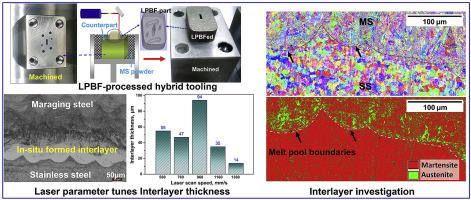International Journal of Machine Tools and Manufacture ( IF 14.0 ) Pub Date : 2020-06-22 , DOI: 10.1016/j.ijmachtools.2020.103592 Chaolin Tan , Xinyue Zhang , Dongdong Dong , Bonnie Attard , Di Wang , Min Kuang , Wenyou Ma , Kesong Zhou

|
Interfacial bonding reliability is a critical issue of metallic multi-material components due to the tendency to delaminate arising from the difference in physical and chemical properties between materials. Here we propose a novel approach to enhance the interfacial bonding through the in-situ synthesis of an interlayer in additively manufactured multi-material hybrid tooling via laser powder bed fusion (LPBF). The effects of laser parameters on tuning the interlayer formation and resulting bonding strength are investigated. The interfacial microstructure evolution, the in-situ formation mechanism of the interlayer, and the interface bond mechanisms are investigated. Intense Marangoni convection and inter-diffusion between two materials in interfacial melt pools, along with Cr redistribution segregation, facilitate the in-situ formation of a Cr-rich interlayer during LPBF process. The in-situ phase transformation behaviour in the interlayer is explained through the Schaeffler-Delong diagram. Mechanical tests, including flexural, tensile and nano-hardness tests, reveal that a strengthened/hardened interface (stronger than parent material) is obtained. The underlying interfacial bonding mechanism of the multi-materials is discussed in terms of the in-situ formed interlayer, Cr segregation and elemental diffusion, in-situ austenite formation together with intrinsic characteristics of the LPBF process. It is found that the in-situ formed interlayer serves to alleviate the interfacial mismatch with Cr-segregation leading to strengthening in the interface, while in-situ austenite formation counteracts residual tensile stress in the melt pool. Hybrid tooling developed in this way integrates complex geometry, improved productivity and high bonding strength.
中文翻译:

原位合成夹层增强了增材制造的多材料混合工具中的结合强度
界面粘合的可靠性是金属多材料组件的一个关键问题,因为材料之间的物理和化学特性差异会导致分层的趋势。在这里,我们提出了一种新颖的方法,可通过激光粉末床熔合(LPBF)在增材制造的多材料混合工具中通过中间层的原位合成来增强界面键合。研究了激光参数对调整中间层形成和所产生的结合强度的影响。研究了界面微观结构的演变,中间层的原位形成机理以及界面键合机理。界面熔池中两种材料之间强烈的Marangoni对流和相互扩散,以及Cr重分布偏析,有助于在LPBF工艺中原位形成富铬中间层。通过Schaeffler-Delong图解释了中间层中的原位相变行为。包括弯曲,拉伸和纳米硬度测试在内的机械测试表明,获得了增强/硬化的界面(比母体材料强)。从原位形成的中间层,Cr偏析和元素扩散,原位奥氏体形成以及LPBF工艺的固有特性等方面讨论了多种材料的基本界面结合机理。已发现原位形成的中间层可减轻与Cr偏析的界面失配,从而导致界面处的强化,而原位奥氏体的形成则抵消了熔池中的残余拉伸应力。











































 京公网安备 11010802027423号
京公网安备 11010802027423号